Resources For Mending Clothes
Resources for Mending Clothes

We toss out over 80 pounds of textiles each year. These textiles are often made of plastic materials (polyester, nylon), made in unethical conditions, dyed with harsh dyes that often get put into the rivers, etc. Even a single cotton shirt releases carbon emissions and uses tons of water.
So the best thing to prevent the unsustainable growth of the fashion industry is to make sure that your clothing lasts as long as possible. To do so, mending clothing is a must. So here are some resources to help you learn how to do various things, such as sewing a button, to tailoring clothes, or even upcycling old clothing into new styles.
* How to sew on three different types of button
* How to hand sew on a patch on a torn pair of jeans
* How to sew up a hole in an old shirt
* How to sew a simple T-shirt
* How to upcycle old clothing into new clothing
* More upcycle and sewing techniques
* How to repair a damaged sock
* How to do an invisible stitch
* 3 different stitches to work with for different results
* How to make a T-shirt smaller so it fits you better
* How to make repairs to your shoes
These are just a few of the things that you can do in order to make sure that your clothing lasts for a long time. Nobody wants to keep buying new clothing, as it is expensive and wasteful.
So making alterations to your clothing, or fixing small holes hen you see them can be hugely beneficial to your wallet, to garment workers, and to the environment in the long term.
More Posts from Imeanmaybesomeday and Others

Tiny kitty that can be made with 2 pipe cleaners. If you care. If you even care.
Why do my interests in canning, couponing, and homesteading overlap so often with blogs with titles like ‘The Obedient Housewife’?

Hard.
lol I am in such a stressed-out blind rage today from insurance bullshit that I wrote up a glossary of health insurance terms (things like deductibles, premiums, and copays) because all the free guides online are unnecessarily complicated and the only way you can squeeze a dime out of these bullshit companies is to understand their overly-complicated policies. give em hell
Please do not let debt collectors play in your face.
Download this easy DIY clothing repair guide (only 10 pages) from Uni of Kentucky

link to PDF
https://fcs-hes.ca.uky.edu/sites/fcs-hes.ca.uky.edu/files/ct-mmb-147.pdf
Oh hey, do you know what time it is? It is highly specific resource time!
Today we have the Royal School of Needlework Stitch Bank! There are HUNDREDS of stitch types in the RSN Stitch Bank.

And more added regularly, let’s look at a recent addition
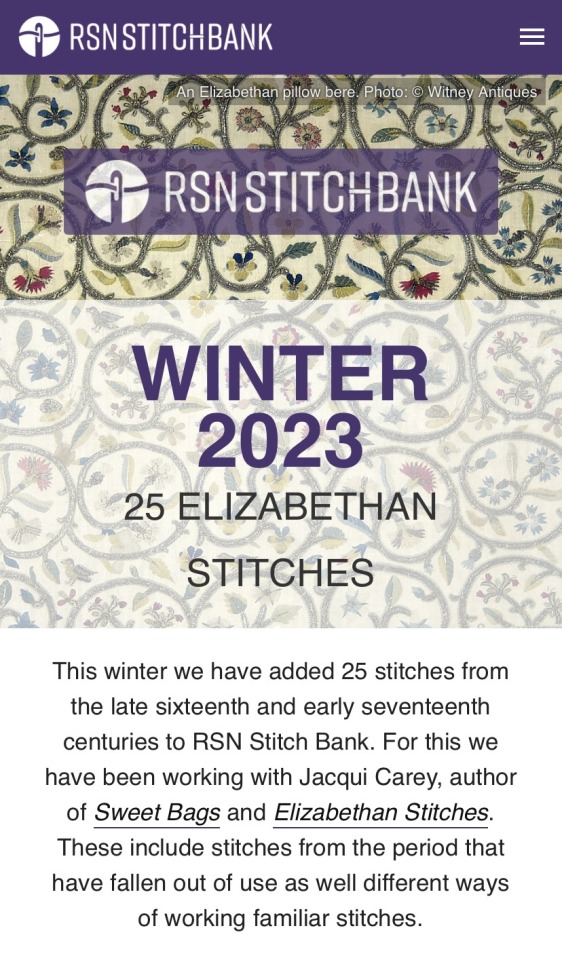

I picked the first one in the 25 recently added Elizabethan stitches, the Elizabethan French Stitch

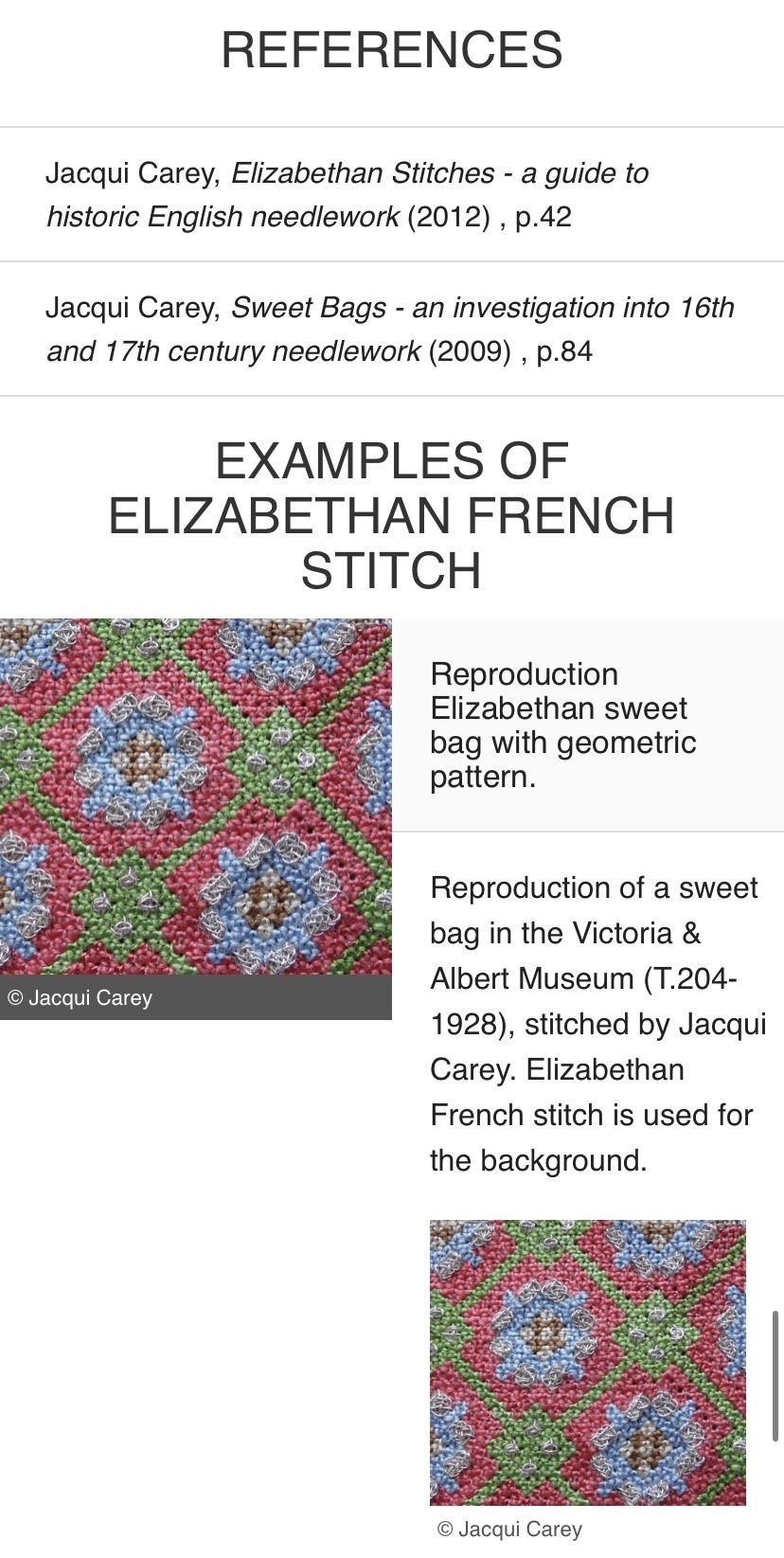
The stitch bank provides written and photo tutorials as well as a video option to learn to do it yourself. There are examples of the stitch in use, resources, references, everything but a needle and thread!
rsnstitchbank.org
Visible Mending
Introduction:
Visible mending is a decorative way to fix up an item. Instead of trying to make your mend as invisible as possible, the idea is to make it part of the garment's design.
Visual mending is not a single technique: it's more of a mindset. If you've got an item you love, it deserves to be mended, and if you're going to put that love into stitches, why not show them off?
That being said, there are some specific techniques that are popular with visible menders. Let's take a look!
Sashiko:
Sashiko is a type of traditional Japanese embroidery that is used to both decorate and reinforce fabric. In visible mending, sashiko is often used to cover up holes with patches or to reinforce thinning fabric. This technique uses a variation on the running stitch.

(Image source)
Some resources on sashiko:
SashiCo on YouTube: sashiko livestreams and information on the cultural aspect of sashiko.
Written tutorial by Upcycle Stitches.
Free sashiko templates by TheSpruceCrafts.
Fixing jeans with sashiko by Soluna Collective.
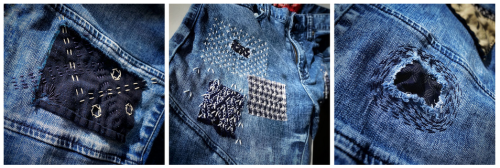
(Image source)
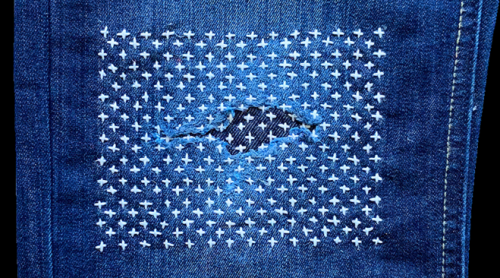
(Image source)
Embroidery:
Regular embroidery is also a popular technique to accentuate your mends. Check out my embroidery 101 post to learn how to get started. You can embroider patches, or use embroidery to hide or accentuate any stitches you've made to fix holes. Embroidery's also a great way to cover up stains.
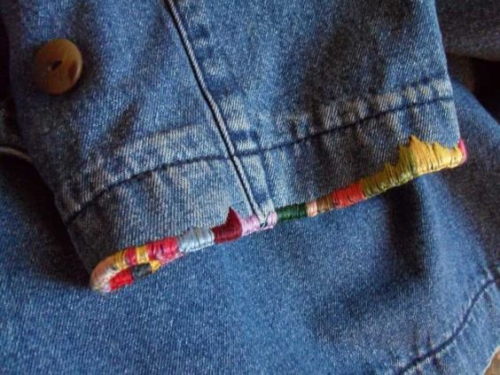
(Image source)
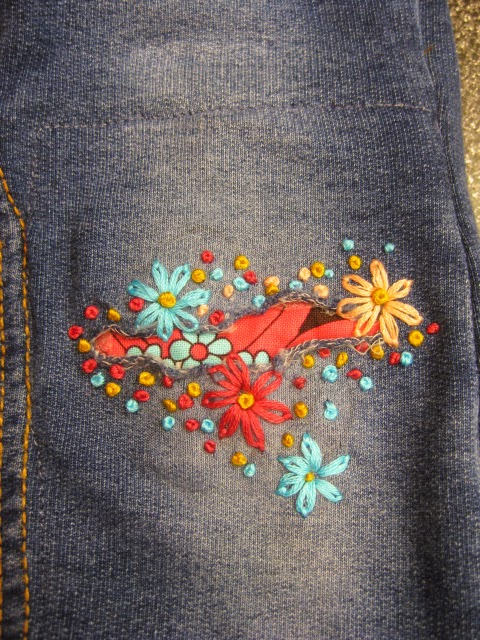
(Image source)
Patches:
There are many ways to add patches to a garment. My tutorial on patches is a good place to start if you want to make custom-shaped patches to sew on top of your fabric. You can also sew your patch on the inside of your garment and have it peek out from beneath the hole you're trying to fix. Fun ideas for this are lace or superheroes.
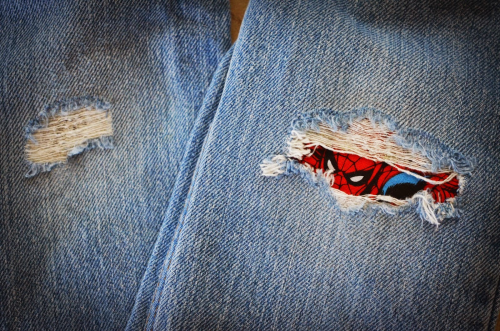
(Image source)

(Source)
Darning:
Darning is a technique used to repair holes in fabric by using running stitches to weave extra fabric over the hole as to fill it up again. While traditionally darning is done in an invisible way by using the same colour of thread as your fabric, you can also use contrasting colours to accentuate your fix. Check out this written tutorial on darning by TheSpruceCrafts.
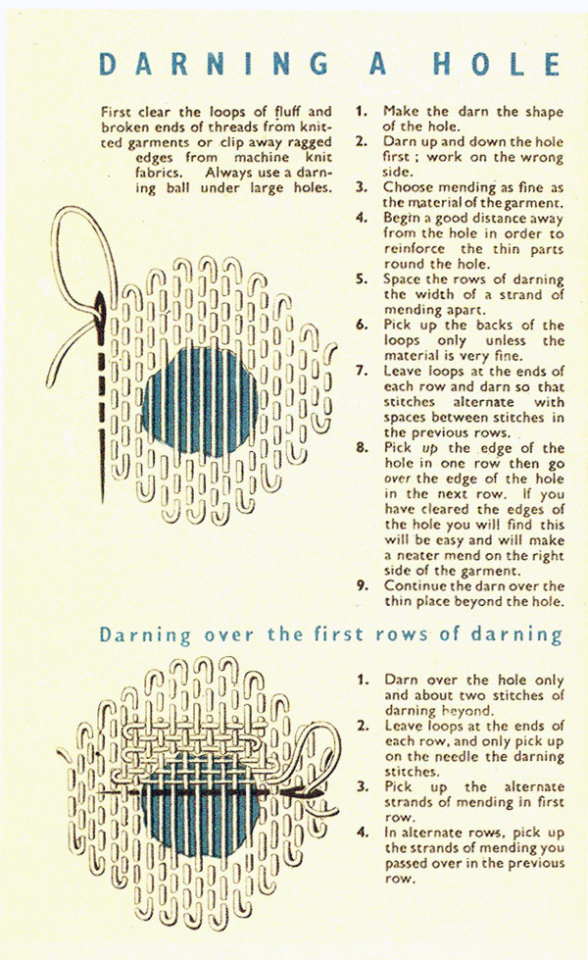
(Image source)
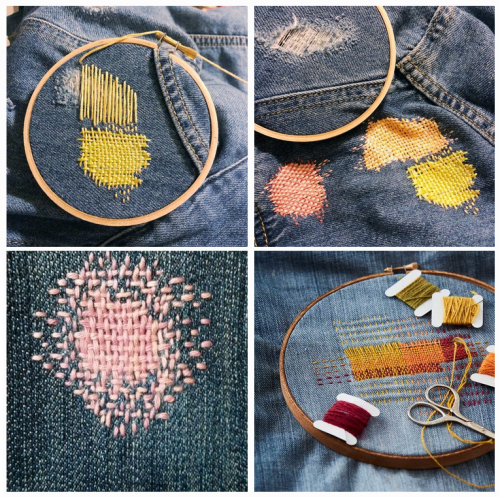
(Image source)
Conclusion:
Visible mending is a creative way to fix up your clothes and give them some personality at the same time.
You should be proud of the fact that you took the time and learned the necessary skills needed to mend your clothes! Show off what you did!
A fun side effect of wearing these obvious mends is that people will notice them. They'll remember your fixes the next time they're faced with a hole in their wardrobe, and it will make them more likely to try it for themselves.
These are just a few ways to visibly mend your garments. Want more inspiration? Check out Pinterest or r/Visiblemending on Reddit.
-
 eveningchillcraft reblogged this · 1 week ago
eveningchillcraft reblogged this · 1 week ago -
 heartpiecesandbassdrops liked this · 2 weeks ago
heartpiecesandbassdrops liked this · 2 weeks ago -
 eternalparadisearchive reblogged this · 2 weeks ago
eternalparadisearchive reblogged this · 2 weeks ago -
 scienceandstorytelling liked this · 2 weeks ago
scienceandstorytelling liked this · 2 weeks ago -
 dreadofthegrave reblogged this · 2 weeks ago
dreadofthegrave reblogged this · 2 weeks ago -
 in-metanoia reblogged this · 2 weeks ago
in-metanoia reblogged this · 2 weeks ago -
 happiness-in-food liked this · 2 weeks ago
happiness-in-food liked this · 2 weeks ago -
 lovelyplaton liked this · 2 weeks ago
lovelyplaton liked this · 2 weeks ago -
 local-seraph liked this · 2 weeks ago
local-seraph liked this · 2 weeks ago -
 quiescentdestiny reblogged this · 2 weeks ago
quiescentdestiny reblogged this · 2 weeks ago -
 hazeleyesallmine liked this · 2 weeks ago
hazeleyesallmine liked this · 2 weeks ago -
 sunsetcocoamuffin reblogged this · 2 weeks ago
sunsetcocoamuffin reblogged this · 2 weeks ago -
 sunsetcocoamuffin liked this · 2 weeks ago
sunsetcocoamuffin liked this · 2 weeks ago -
 jagborimumindalen liked this · 2 weeks ago
jagborimumindalen liked this · 2 weeks ago -
 remoryu liked this · 2 weeks ago
remoryu liked this · 2 weeks ago -
 luarenah reblogged this · 2 weeks ago
luarenah reblogged this · 2 weeks ago -
 snailswithwings liked this · 3 weeks ago
snailswithwings liked this · 3 weeks ago -
 machinesbleedtoo liked this · 3 weeks ago
machinesbleedtoo liked this · 3 weeks ago -
 sonefire liked this · 3 weeks ago
sonefire liked this · 3 weeks ago -
 noxernia reblogged this · 3 weeks ago
noxernia reblogged this · 3 weeks ago -
 abortionpostbirth liked this · 3 weeks ago
abortionpostbirth liked this · 3 weeks ago -
 pastelmapeach reblogged this · 3 weeks ago
pastelmapeach reblogged this · 3 weeks ago -
 pastelmapeach liked this · 3 weeks ago
pastelmapeach liked this · 3 weeks ago -
 mxgicthot reblogged this · 3 weeks ago
mxgicthot reblogged this · 3 weeks ago -
 athos-silvani reblogged this · 3 weeks ago
athos-silvani reblogged this · 3 weeks ago -
 melsie-art-archive reblogged this · 3 weeks ago
melsie-art-archive reblogged this · 3 weeks ago -
 sockfluff reblogged this · 3 weeks ago
sockfluff reblogged this · 3 weeks ago -
 sassy-saves-stuff reblogged this · 3 weeks ago
sassy-saves-stuff reblogged this · 3 weeks ago -
 ladyknight33 reblogged this · 3 weeks ago
ladyknight33 reblogged this · 3 weeks ago -
 hcfhhgg liked this · 3 weeks ago
hcfhhgg liked this · 3 weeks ago -
 snowflakesincalifornia reblogged this · 3 weeks ago
snowflakesincalifornia reblogged this · 3 weeks ago -
 inkxplashes reblogged this · 3 weeks ago
inkxplashes reblogged this · 3 weeks ago -
 wrathfuldissonance liked this · 3 weeks ago
wrathfuldissonance liked this · 3 weeks ago -
 valmun reblogged this · 3 weeks ago
valmun reblogged this · 3 weeks ago -
 nobodysvoice22 reblogged this · 3 weeks ago
nobodysvoice22 reblogged this · 3 weeks ago -
 nobodysvoice22 liked this · 3 weeks ago
nobodysvoice22 liked this · 3 weeks ago -
 anomalous-skink reblogged this · 3 weeks ago
anomalous-skink reblogged this · 3 weeks ago -
 middernachtlopper liked this · 3 weeks ago
middernachtlopper liked this · 3 weeks ago -
 peachesanmemes reblogged this · 3 weeks ago
peachesanmemes reblogged this · 3 weeks ago -
 peachesanmemes liked this · 3 weeks ago
peachesanmemes liked this · 3 weeks ago -
 devondowner reblogged this · 4 weeks ago
devondowner reblogged this · 4 weeks ago -
 mmmmwaffles94 reblogged this · 4 weeks ago
mmmmwaffles94 reblogged this · 4 weeks ago -
 sparkzstar reblogged this · 4 weeks ago
sparkzstar reblogged this · 4 weeks ago -
 averagetransman reblogged this · 4 weeks ago
averagetransman reblogged this · 4 weeks ago -
 i-hate-bald-people reblogged this · 4 weeks ago
i-hate-bald-people reblogged this · 4 weeks ago -
 miz-orque reblogged this · 4 weeks ago
miz-orque reblogged this · 4 weeks ago -
 bokch01s liked this · 4 weeks ago
bokch01s liked this · 4 weeks ago -
 i-hate-bald-people liked this · 1 month ago
i-hate-bald-people liked this · 1 month ago
